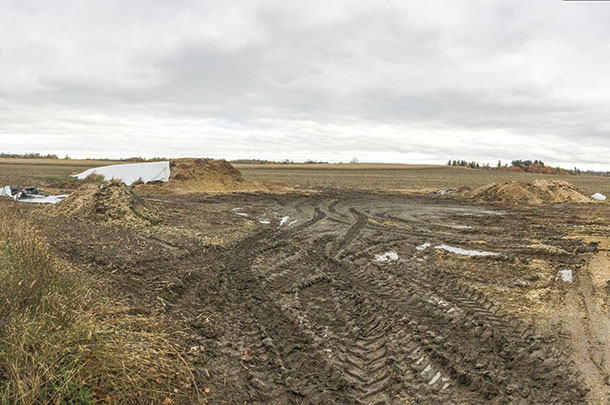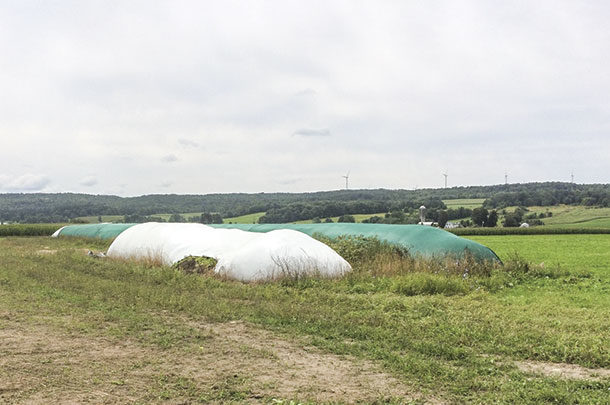Lots of rain throughout late spring/early summer in the Northeast delayed the growing season and cut into the quality of first-crop forages, while good weather and adequate rain yielded a good-quality harvest in the Midwest.
When forage yield is higher than expected or yields are of lower quality than expected, storing forages like silage or haylage could require using a temporary location, especially when trying to separate and store forages according to quality.
In a webinar broadcast by Cornell University’s PRO-Dairy program, presenters Ron Kuck, dairy/livestock educator with Cornell’s Jefferson County Extension and Joe Lawrence, dairy forage systems specialist with Cornell University’s PRO-Dairy program, addressed the challenges of storing forages at a satellite storage site.
Kuck used this year’s first-cutting hay crop in New York state as an example of when alternate storage sites would be needed. “We had lots of first-cutting haylage that was poor quality and took up a lot of room,” he said. “Second, third and possibly fourth cutting might have to go somewhere else because of space limitations and separating for quality.”
He said it’s the same issue with corn silage: “Some corn silage is mature, and we’re going to want to put that in one place, and other corn silage is not going to mature, so we need to keep that separate so we can feed it to a different class of animal.”
Silage bags
Kuck and Lawrence said plastic forage bags are one of the best ways to store extra forage. When farmers have extra forage, or forage they want to segregate, it’s tempting to put it directly on the ground or somewhere without a good foundation.
“If you can’t do a very good job preserving that forage, you end up losing half of it to spoilage or mud, so we’ve been suggesting folks go with silage bags,” Kuck said. “The main thing is that you’ll be able to preserve most of what you store in a silage bag and you won’t have as much shrink.” Kuck said the amount of shrinkage with a silage bag stays around 5 to 8 percent.
He said if a drive-over pile is made directly on the ground or in an unprepared spot, it is possible for a farmer to lose up to half of the pile due to shrinkage.
Kuck said plastic storage bags are also adaptable to any size of operation. “For some of these smaller dairies that don’t have the tractor power or the help to make a good drive-over pile or a bunk silo, the silage bags work really well,” said Kuck. “We even have dairies in our county that milk 4,000 cows that use silage bags.”
Solid foundation
Kuck and Lawrence said the ideal temporary storage site needs to include two things: a solid foundation that provides good drainage and easy access for feeding.
This slideshow illustrates the requirements of temporary storage.
“If you’re going to make a drive-over pile, it needs to be on asphalt or cement,” Kuck said. “You can’t be on the ground because you just can’t pack it hard enough.” He said having enough tractor power to pack forage correctly to eliminate oxygen to aid in fermentation is also an important part of proper forage storage.
“If you don’t pack your bunks to the right density, you won’t ferment very well, and you’ll still have a lot of shrink and waste because of that.”
Lawrence said packing and sealing forage is a struggle most farmers face, which can make temporary storage sites more difficult to deal with. “We know it’s a challenge in permanent storage structures when you’re dealing with a pile or bunk, and when you take that example and put it on a temporary site, it makes it even more difficult to get your packing done properly and get the silage covered.”
Accessibility
The second important feature of the ideal forage storage site is accessibility. Both Kuck and Lawrence said a well-drained site is of paramount importance. Good drainage can help the site itself stay in good condition and be less muddy through the winter months, which keeps the field from getting torn up from the traffic in and out and decreases the amount of feed that gets mixed into the mud.

Good drainage can also help prevent liquids released through fermentation from leaching through the soil and into nearby water sources. Lawrence said a well-drained field that’s not too close to a body of water would be a great place to set up a temporary storage site.
Kuck and Lawrence said thoroughly checking the site against any existing regulations is important. “If you’re under some sort of nutrient management planning guidelines, whether it’s the EPA or state government, there may be restrictions on where you can site the storage for runoff issues,” Lawrence said.
Plan ahead
Something Kuck and Lawrence have been trying to emphasize with producers they advise is making a plan for temporary storage sites for if or when they become necessary. “You never know, it could be a drought year or a year with lots of extra forage, but having some sort of plan in place is smart for multiple reasons,” Lawrence said. “One, it’s going to allow you to most effectively utilize that feed.
Two, we see scenarios when it’s not planned ahead, resulting in a last-minute decision, and it ends up being put in a place where we end up with a lot of spoilage in the feed.”
Kuck said it’s important to have a plan in place before it becomes necessary to use it. “Now is the time to plan ahead; now is the time to prepare for that. People should be getting out and scouting their fields and have a plan of what they’re going to do way ahead of time, like right now.”
Whether it’s a bumper-crop year or a low-quality year, having a plan in place for temporary forage storage can help use all of your resources – land, forage and time – to the fullest advantage. ![]()
PHOTO 1: This temporary storage site for silage bags was placed on high ground in a field with large buffers between the storage and any surface water. In the absence of an improved pad (stone, cement, etc.) to store the feed on, this minimizes the potential of ending in the mud while feeding out.
PHOTO 2: This temporary drive-over pile stored in a field is an example of a poorly designed temporary storage. Photos by Joe Lawrence.

-
Carrie Veselka
- Associate Editor
- Progressive Dairyman
- Email Carrie Veselka










